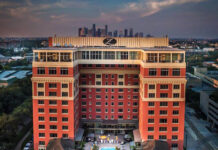In the past, U.S. developers may have looked to Europe for influence and as the inspiration behind building smaller guestrooms, especially in markets where land was at a premium. In major markets and even tertiary markets in Europe, boutique hotels were typically smaller in nature, says Ron Pohl, senior vice president of brand management and member services at Best Western International. “It was that uniquely designed hotel with the local flair, the intimate setting, and the service elements that people really enjoyed when traveling to Europe,” Pohl says.
More recently, Best Western executives noticed developers were taking a similar approach with larger boutique properties, marrying smaller guestrooms with expansive public spaces. “We were intrigued by that approach, not only from a customer perspective and bringing that over to the States, but also from a developer’s perspective,” Pohl says.
To capture its share of the growing lifestyle segment, Best Western wanted to develop a brand with a modern theme rather than the more historic nature of European hotels. Pohl and other Best Western executives scoped out brands like Motel One and CitizenM in Europe, as well as contemporary hotels in China, Korea, and Bangkok. The goal was to combine the best of both worlds and create a brand that would be desirable in urban U.S. markets. The result was Vib. “We took all of our learnings from that and started working with a design firm in Texas that could help us create the space we wanted and bring that boutique segment into the upper midscale market with Vib,” Pohl says.
Lifestyle brands like Marriott’s Moxy, which targets tech-savvy, budget-minded millennials, are even taking cues from the Generators of the world. During a panel at the Hospitality Design (HD) Expo in Las Vegas in May, Eric Jacobs, chief development officer of North America lodging at Marriott International, described Moxy as having “hostel-style” guestrooms, some of which feature bunk beds. Peg walls that run along the side of the rooms hang portable furniture, and desks have been eliminated from the equation. Like Generator, Mama Shelter, and Vib, Moxy emphasizes its public spaces. “This brand will be focused on the generation that is much more about the bar and the scene they’re in,” Jacobs said. Moxy debuted in Milan in 2014, and the first U.S. locations are scheduled to open this December, in New Orleans and Tempe, Ariz.
While most of the new lifestyle brands skew younger, Pohl says the trend of tiny guestrooms and big lobbies is less a reaction to the millennial generation and more about a general desire to have great social experiences. “I think the whole thing started with the communal approach, with Starbucks and a number of other retail-type vendors and settings, where people started to enjoy being in spaces together and liked hanging out and doing business in that environment,” he says.
One thing is for certain—this type of hotel model won’t work everywhere. Pohl doesn’t feel Vib or its competitors have a great chance for success in non-urban locales. Ideal markets have high visibility and a lot of foot traffic. “You need the big markets where customers are spending a lot of time outside the guestroom and enjoying the city,” he says. “And you don’t get that energy in a lobby or a public space environment with just hotel guests; you have to be attractive to the customers in the local area.”
Best Western has signed four Vibs so far, in Miami, Chicago, Los Angeles, and Springfield, Mo., with the first hotel likely to open in the next 12 to 16 months. There is also another property signed in Seoul, Korea, which is about two years away from opening. “We’re not going to approve developers that want to put this some place other than an urban-type setting where the contemporary nature and design really fits in the community,” Pohl explains.
Other than high-speed internet, Vib isn’t giving anything away. Breakfast options in the café are à la carte, and the lounge is another profit center for owners. “It’s cost-effective to build, it’s efficient to operate, and we see this being a profitable business model for the developer at an attractive price point for the consumer,” Pohl says.
The underlying challenge with having postage-stamp-sized hotel rooms is educating consumers so they aren’t surprised or disappointed when they check in. Luckily, in cosmopolitan cities like New York, Chicago, and Los Angeles, room sizes are already pretty small, unless it’s a luxury property. Talking about Tommie, the new micro lifestyle brand from Commune Hotels & Resorts, at HD Expo, Todd Wynne-Parry, EVP of acquisitions and development, said, “I have this reoccurring nightmare where a middle-aged couple from the Midwest checks into a Tommie, buying a room at a price point and realizing the room is so small, you have to step outside to change your mind.” The first Tommie will open this fall in New York City’s Hudson Square. Because the average room size is 160 square feet, Wynne-Parry has his qualms about attracting the wrong demographic or unsuspecting customers, but he expects consumer awareness of micro-rooms to increase over the next three to five years.
Generator’s Wyatt says small rooms aren’t problematic; it’s when the average daily rate is disproportionately high that they become a challenge for owners. Generator’s rates for private rooms are typically around $89 to $109 a night, while shared rooms are only about $35 per night, Wyatt says. “If you as a hotelier offer the right product at the right price, you shouldn’t have a problem. We’re not too worried about it.”











